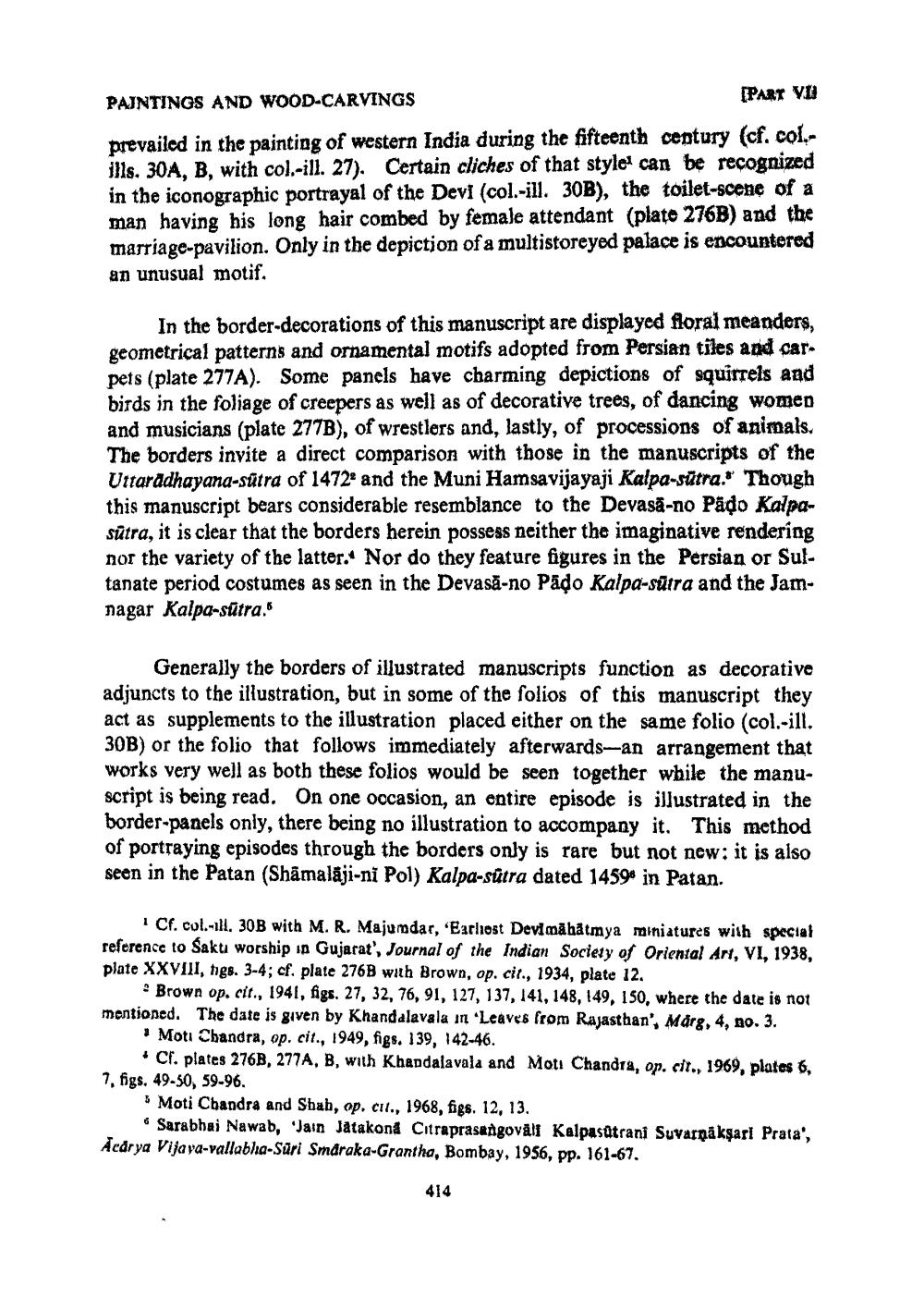________________
PAINTINGS AND WOOD-CARVINGS
[PART VI
prevailed in the painting of western India during the fifteenth century (cf. col.ills. 30A, B, with col.-ill. 27). Certain cliches of that style can be recognized in the iconographic portrayal of the Devi (col.-ill. 30B), the toilet-scene of a man having his long hair combed by female attendant (plate 276B) and the marriage-pavilion. Only in the depiction of a multistoreyed palace is encountered an unusual motif.
In the border-decorations of this manuscript are displayed floral meanders, geometrical patterns and ornamental motifs adopted from Persian tiles and carpets (plate 277A). Some panels have charming depictions of squirrels and birds in the foliage of creepers as well as of decorative trees, of dancing women and musicians (plate 277B), of wrestlers and, lastly, of processions of animals. The borders invite a direct comparison with those in the manuscripts of the Uttaradhayana-sutra of 14722 and the Muni Hamsavijayaji Kalpa-sutra." Though this manuscript bears considerable resemblance to the Devasā-no Pädo KalpaSūtra, it is clear that the borders herein possess neither the imaginative rendering nor the variety of the latter. Nor do they feature figures in the Persian or Sultanate period costumes as seen in the Devasā-no Pädo Kalpa-sūtra and the Jamnagar Kalpa-sütra."
Generally the borders of illustrated manuscripts function as decorative adjuncts to the illustration, but in some of the folios of this manuscript they act as supplements to the illustration placed either on the same folio (col.-ill. 30B) or the folio that follows immediately afterwards--an arrangement that works very well as both these folios would be seen together while the manuscript is being read. On one occasion, an entire episode is illustrated in the border-panels only, there being no illustration to accompany it. This method of portraying episodes through the borders only is rare but not new: it is also seen in the Patan (Shãmalāji-ni Pol) Kalpa-sutra dated 14596 in Patan.
1 Cf. col.-Il. 30B with M. R. Majumdar, 'Earliest Devi mahatmya miniatures with special reference to Sakt worship in Gujarat', Journal of the Indian Society of Oriental Art, VI, 1938, plate XXVIII, tige. 3-4; cf. plate 276B with Brown, op. cit., 1934, plate 12.
. Brown op. cit., 1941, figs. 27, 32, 76, 91, 127, 137, 141, 148, 149, 150, where the date is not mentioned. The date is given by Khandalavala in Leaves from Rajasthan, Märg, 4, no. 3.
Moti Chandra, op. cit., 1949, figs. 139, 142-46.
• Cl. plates 276B, 277A, B, with Khandalavala and Moti Chandra, op. cit., 1969, plates 6, 7, figs. 49-50, 59-96.
Moti Chandra and Shah, op. cit., 1968, figs. 12, 13.
Sarabhai Nawab, 'Jain Jatakona Citraprasangoväli Kalpasūtrani Suvarnäksari Prata', Acarya Vijaya-vallabla-Suri Smáraka-Grantha, Bombay, 1956, pp. 161-67.
drya Vijava-wanawab, Jain labi u., 1968, figs. 12
414




